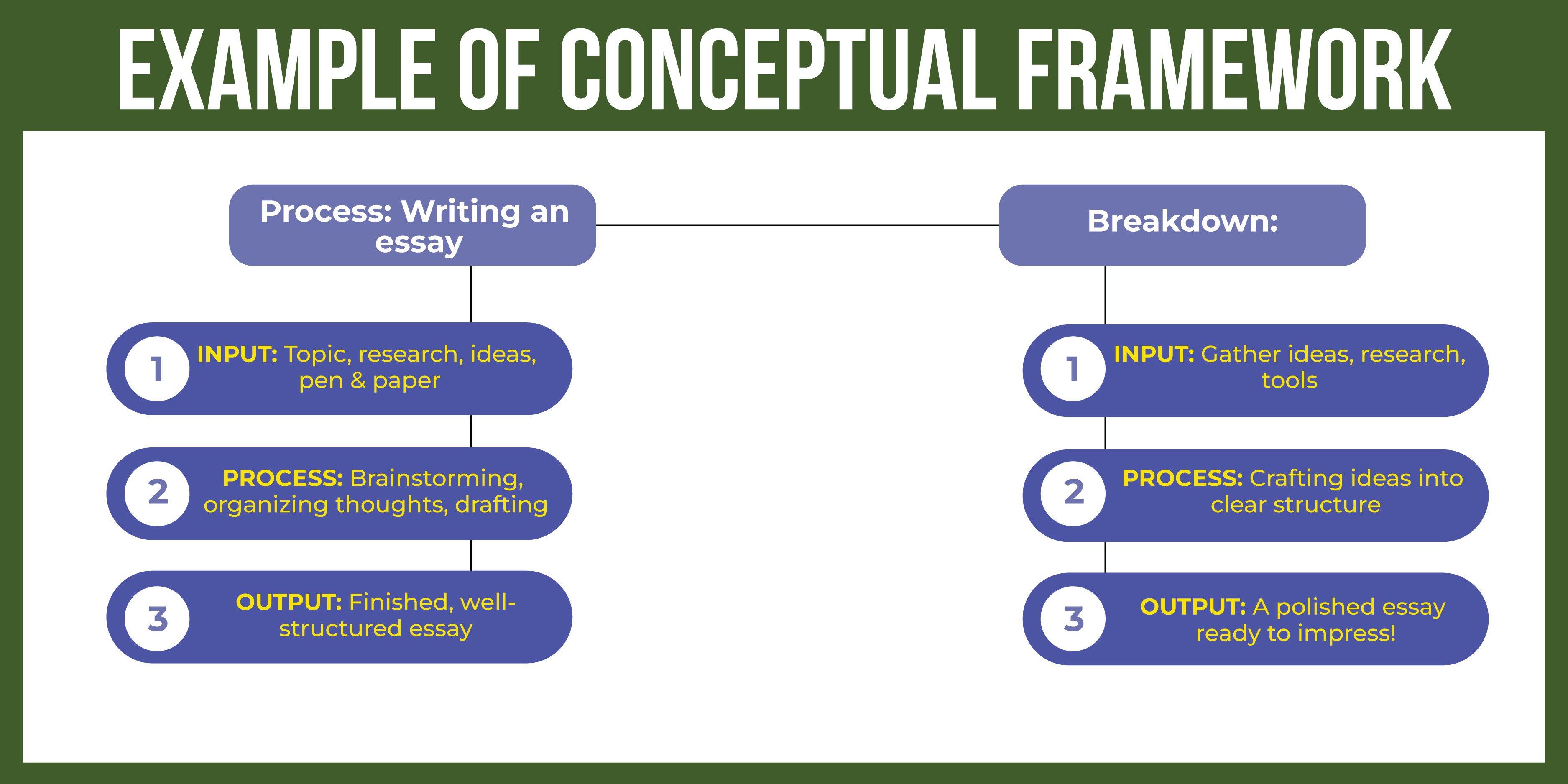Decoding the Conceptual Framework: Purpose and Importance

Table of Contents
- How to Build a Strong Conceptual Framework for Research
- Where Can You Apply a Conceptual Framework?
- How to Create an Effective Conceptual Framework
- 20 Must-Explore Topics in Conceptual Frameworks
- Examples of Conceptual Frameworks
- Learn About Conceptual Framework From Our Experts!
- Frequently Asked Questions
Creating a concept framework may sound complex to you. But we assure you, it is almost like piecing a puzzle together. This comprehensive guide will teach you about conceptual framework and how to use it in research with relevant examples. Lets dive into the nuts and bolts to make academic work more structured, logical and impactful.
How to Build a Strong Conceptual Framework for Research
Let us suppose that you are building a house by yourself. Surely, you will need a blueprint, before you start with laying bricks and painting the walls right? A conceptual framework is that blueprint for your work; it shows you where everything is supposed to be.
In academics, it gives a solid structure to your work. It shows the relationship between two variables and how they affect each other. A variable is a factor that is measured in a study. They explain how different concepts relate to each other.
The following sections, you will explore how you can build a strong structure with tiny description of an example of conceptual framework.
Select a clear topic
A good topic lays the ground for the variables. Also, it will help you stay on track with your studies. So choose a specific topic that is meaningful. You should learn conceptual framework definition to narrow your focus.
Perform literature review
A literature review helps with background context and helps you identify the gaps in existing studies. Also, it allows you to identify the primary concepts. A quick conceptual framework explanation example can help show how these ideas connect in your work.
Identify the variables
You need to pick the correct variable because it forms the core of your framework. There are two types of variables:
- Independent- This is the factor that you can change or control.
- Dependent- This is the factor that you measure in response to changes. It depends on the independent variable.
A quick look at what is conceptual framework in research example can show how these variables connect in practice.
Define the Relationship Between Variables
After you find the key variables, you need to know how they are related to each other. It is more like a cause-and-effect relationship. So, you need to explain how different ideas are connected and offer a direction.
Similarly, in other fields like accounts, IASB Conceptual Framework guides the development of financial reporting standards.
Present Clear Explanations
In this step, you describe each variable, how they relate and why the relationship between them is crucial. You must demonstrate how your framework fits your research in this part. In addition, you may look at a conceptual framework example to apply it in your work.
Where Can You Apply a Conceptual Framework?
A conceptual framework finds the relationship between variables in a study, and how they affect and influence each other. Also it is crucial to find where you can apply this framework. So we have curated a list to help you in how to apply.
Research
In your research, it can help you structure and organise your ideas in a concise way. Moreover, it defines the primary concepts and relates them to ideas and variables. To truly grasp the conceptual framework meaning, think of it as the blueprint that connects your topic and data.
Case Study
In case study analysis, it permits you to focus on specific elements and connect them with real-world. This also allows you to describe why a specific event happened. A valuable tool like a dissertation outline generator can help you with a structure to organise your variables logically.
Business
In the business, a strong framework helps leaders make smart, data-driven decisions. Big companies use it to study markets, launch new products and handle competition. Students can understand the conceptual framework independent and dependent variable helps to clarify how actions influence results.
Now that you learn about how you can apply concept framework in your work, let us move to how you can create one.
How to Create an Effective Conceptual Framework
Now you know what is a conceptual framework but do you know that most strong research projects begin with a clear conceptual framework? It gives your study a direction and helps others to understand your ideas. You can read this list to know further.
Define Your Research Problem
The first and foremost step is to define a clear research problem. It is the foundation of your work as it outlines the issue you will investigate.
Once you find a problem, you need to identify key variables that are involved. This step is paramount to master conceptual framework in research
Start With Literature Review
A literature review means that you read as many journals and books that are related to your topic. Also, it will benefit you to find the gaps in the existing studies. It also acts as a guide for you to refine your theoretical framework and ensures that it is relevant to your study goals.
Identify Key Variables or Concepts
When you identify your research problem, the next step is to find the main variables that will guide your study. These should be measurable factors.
Before going further, you need to learn the differences between moderating and mediating variables.
- Moderating- How the variables are related
- Mediating- It affects the direction of their relationship.
Establish Logical Relationships
To form a conceptual framework, you should start by relating the key concepts in a logical way. Also, you should identify the main ideas in your research and figure out how they connect.
These logical connections help you visualise the flow of your research and how each concept influences the other. Moreover, you can explain with a conceptual framework example, this will enhance your paper.
Align It With Objectives and Goals
Your framework should reflect your objectives. So, you make sure that the framework is designed to answer your question. If your goal is to study social media’s effect on behaviour, the concepts you choose should directly relate to that goal.
Also, you can seek dissertation writing services if you need extra support in shaping your framework.
Prioritise Simplicity over Complexity
You should keep your framework simple and clear. So, you should avoid adding too many concepts and make it complicated. A straightforward framework is easier to follow and ensures your research is focused.
Also, you should choose only the most relevant variables that directly impact your question. The simpler your work, the more effective it will be in your study.
An example of conceptual framework in quantitative research can guide you to select the variables.
Document Assumptions and Limitations
Assumptions are ideas you believe to be true for your research. It is like assuming a specific relationship exists between two variables. A conceptual framework for financial reporting can guide you in identifying such assumptions in financial contexts.
Limitations refer to constraints of time or resources. It can affect the results. Acknowledging these helps clarify the scope of your study and ensures transparency.
Base it on Existing Theories and Evidence
Your framework should be grounded in the existing theories and evidence. It helps to provide a solid foundation for your study. A strong framework is not only related to academics but it also acts as your map to think and present your ideas.
Now you understand what is a conceptual framework and its paramountcy. Think of it as a GPS for your academic journey. Without it, you are wandering with a map full of places you barely remember.
20 Must-Explore Topics in Conceptual Frameworks
Here is a list of unique topics that you must explore to develop concept framework and craft a substantial research.
- How does Metacognition impact the student learning process?
- What is the role of emotional quotient and intelligence?
- How do cognitive functions shape our perspectives?
- How does social media affect our behaviour?
- What are the groundsof social justice in human rightscontext?
- What is the contribution of ethical valuesin the corporate system?
- How does global warming affect human health?
- How do physical exercisesaffect overall academicperformance?
- What is the impactof critical thinking in scientific inquiry?
- How does mental health affect learningin students?
- How does privilege shape education outcomes?
- How does feedback affect student learning?
- How do political systems shape educational development?
- What is the role of artificial intelligence in the healthcare world?
- How do advertisements affect the consumer behaviour?
- How do policies of migration affect the economic growth ?
- How does taking risks affectlearningand innovation in students?
- What is the role of memory in learning complex concepts?
- How does cultural diversity impact dynamics in a workplace?
- Why do cultural narratives shape gender identity?
- How does unemployment affect a person's mind?
You can take inspiration from these topics and create a strong structure for conceptual framework. As you know, professors look for a robust study as it shows that you have a clear understanding of the topic with a structure. Let us move to the examples to lean better.
Examples of Conceptual Frameworks
Now that you have an idea about topics, let us see an example of conceptual framework in qualitative research. For your convenience, we have picked the topic from the above listing. Using these examples will help you create a solid framework in no time. let us begin.

Example 1
Research Question: How do physical activities influence the academic performance of students?
|
Component |
Details |
|
Independent Variable |
Physical Activity– Includes sports, regular exercise |
|
Dependent Variable |
Academic Performance– measured through grades, test scores. |
|
Supporting Variables |
Sleep quality- Stress levels - Time management - Cognitive function |
|
Theoretical Basis |
Cognitive Load Theory– Physical activity helps refresh the brain, improves focus and memory. |
|
Purpose of Framework |
To explore how physical activities can support better academic results in students. |
|
Hypothesis Link |
More physical activity → better mental health → improved focus and energy → higher academic results |
Example 2
Research Question: How does social media influence the behaviour of teenagers?
|
Component |
Details |
|
Independent Variable |
Social Media Usage – time spent on Instagram, Snapchat, etc. |
|
Dependent Variable |
Teen Behaviour– measured through changes in self-esteem and social anxiety. |
|
Supporting Variables |
Peer influence - Family dynamics - Offline social interactions |
|
Theoretical Basis |
Social Learning Theory – teens imitate behaviours seen online |
|
Purpose of Framework |
To explore how social media affects emotional well-being and social behaviours. |
|
Hypothesis link |
More social media exposure → increased comparison → lower self-esteem → changes in behaviour |
By now, you have seen that conceptual framework is not just a boring academic requirement. It is a secret weapon to organise your thoughts and present your ideas clearly. The stronger your framework, the more confident your work will be.
Learn About Conceptual Framework From Our Experts!
Need a helping hand to create strong conceptual framework in research? At Global Assignment help we offer expert writing services crafted by real academic professionals with authentic, tailored work.
Whether you are facing a problem to building a framework or want flawless content that meets the academic standards, our team is here to support you with:
- 100% original content
- Unlimited revisions
- On-time delivery
Let your ideas shine with clarity and confidence. Get expert help with assignment writing services UK for work you can trust and grades you will be proud of.
Frequently Asked Questions
1. How do you write a Conceptual Framework?
To write a conceptual framework, you need to :
- Define your research question
- Identify key variables
- establish their relationships
- Use theories to support
- Present ideas with diagrams for clarity and focus.
2. What are the primary components of the Conceptual Framework in Research?
There are 3 components that you can include in your research: Generation, explanation and argumentation. It will create a comprehensive model to justify your research question. These elements will help you guide the research and explain how concepts connect.
3. What is the key difference between a theoretical and conceptual framework?
A theoretical framework explains existing theories related to your study.
It also shows how variables in your research are linked with each other. This framework guides your study, while the conceptual organises your research focus.
4. What is the aim of a concept framework?
The primary objective of a concept framework is that it provides clarity and direction for your study. It helps to define the main concepts and shows how they are related. Also, it supports the objectives of your research.
5. What are the three main variables in a concept framework?
The three main variables are:
- Independent Variable- The factor you manipulate or change.
- Dependent Variable - The outcome you measure.
- Moderating Variable- Factors that influence the relationship between the independent and dependent variables.
Free Tools

Easy to Use Paraphrasing Tool to Simplify Complex Academic Writing
Check Now
Get Structured Outline by Professionals for Your Dissertation
Check Now
Effortlessly manage citations and references with our smart referencing tool
Check NowLatest Blogs

- 04 Nov 2025
- 300 Views

- 30 Oct 2025
- 1472 Views

- 28 Oct 2025
- 276 Views

- 27 Oct 2025
- 425 Views
- Plagiarism
- Pricing
- Order Now
- Call Back
- Live Chat

Limited Time Offer
Exclusive Library Membership + Free 300$ Wallet Balance

Get $300 Now
Update your Number






















Thank you for submitting your comment on this blog. It is under approval. We will carefully review your submission and post it on the website.